Auditing Report: Financial Statements Analysis and Internal Controls
VerifiedAdded on 2023/01/06
|11
|3096
|97
Report
AI Summary
This report provides a comprehensive analysis of auditing principles and practices, focusing on the examination of financial statements and internal controls. It begins with an introduction to auditing, emphasizing the importance of independent audits for publicly traded companies and the need for sufficient and appropriate audit evidence. The main body of the report addresses several key questions, including the definition of sufficient audit evidence, the interpretation of financial ratios (current ratio, quick ratio, net profit ratio, and gross margin ratio), the identification of internal control weaknesses within a company, and the evaluation of an auditor's conclusions. Specific examples are provided to illustrate these concepts. The report also outlines audit procedures for revenue verification and discusses the roles and independence of internal and external auditors, including the importance of internal control and operational systems.
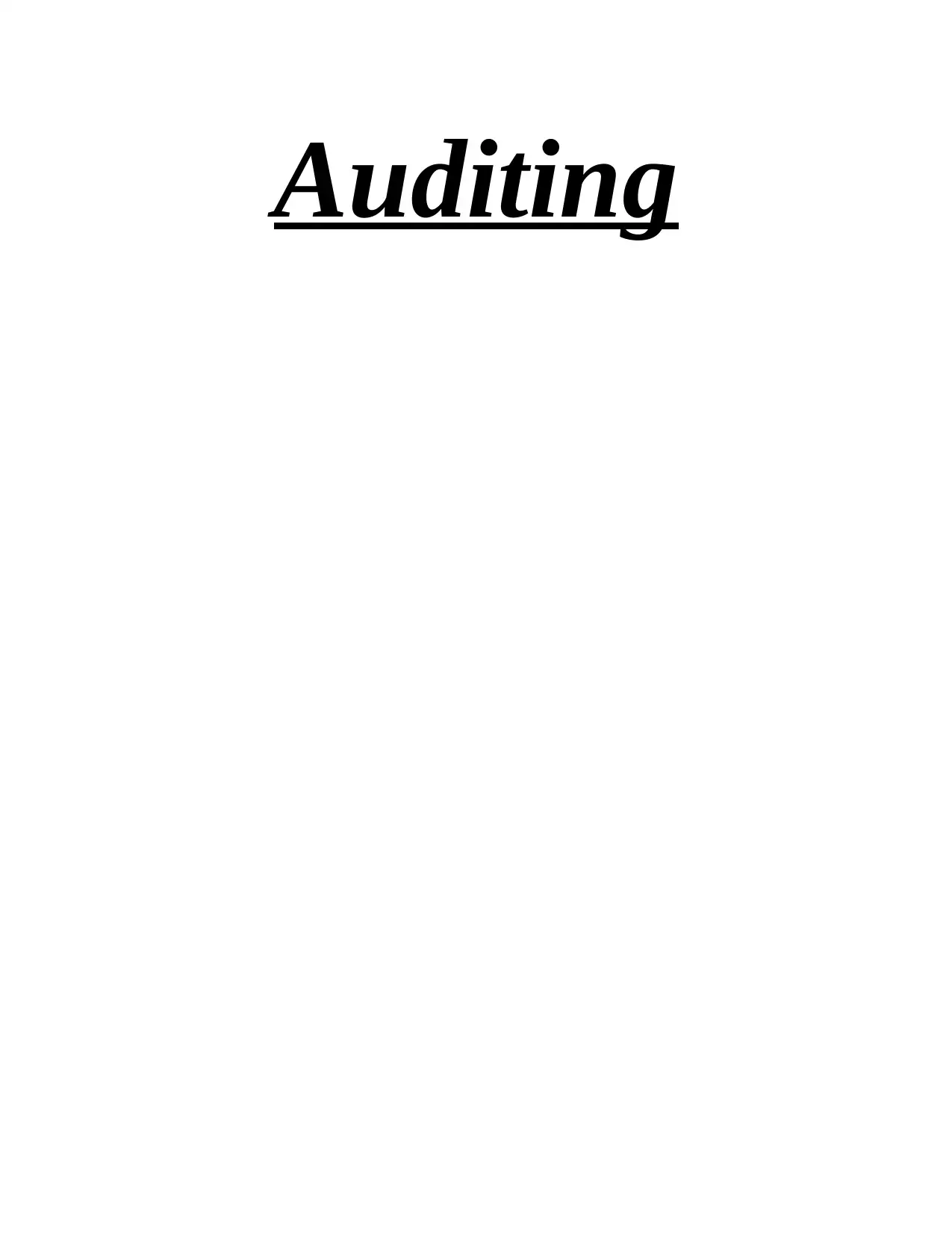
Auditing
Secure Best Marks with AI Grader
Need help grading? Try our AI Grader for instant feedback on your assignments.
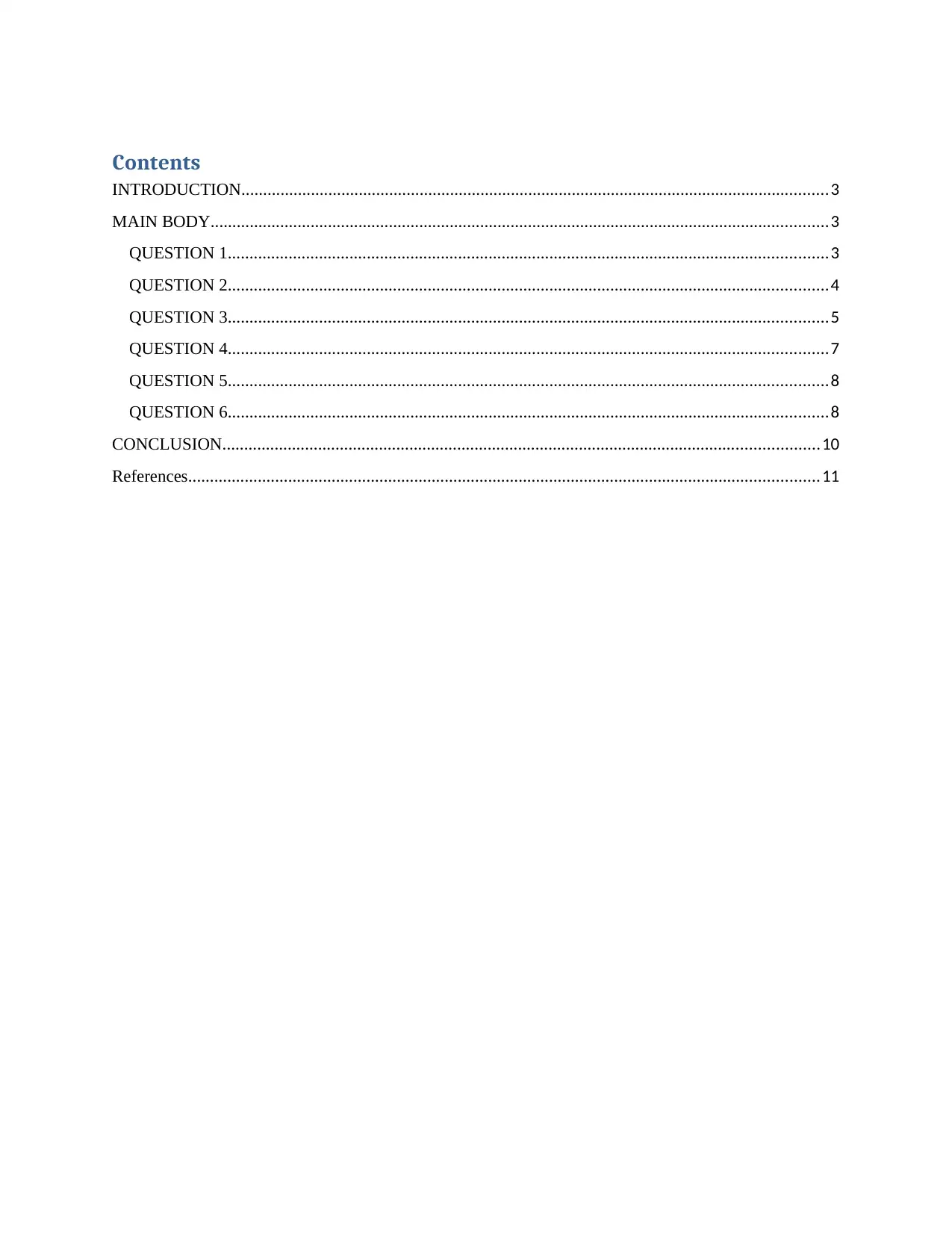
Contents
INTRODUCTION.......................................................................................................................................3
MAIN BODY..............................................................................................................................................3
QUESTION 1..........................................................................................................................................3
QUESTION 2..........................................................................................................................................4
QUESTION 3..........................................................................................................................................5
QUESTION 4..........................................................................................................................................7
QUESTION 5..........................................................................................................................................8
QUESTION 6..........................................................................................................................................8
CONCLUSION.........................................................................................................................................10
References.................................................................................................................................................11
INTRODUCTION.......................................................................................................................................3
MAIN BODY..............................................................................................................................................3
QUESTION 1..........................................................................................................................................3
QUESTION 2..........................................................................................................................................4
QUESTION 3..........................................................................................................................................5
QUESTION 4..........................................................................................................................................7
QUESTION 5..........................................................................................................................................8
QUESTION 6..........................................................................................................................................8
CONCLUSION.........................................................................................................................................10
References.................................................................................................................................................11
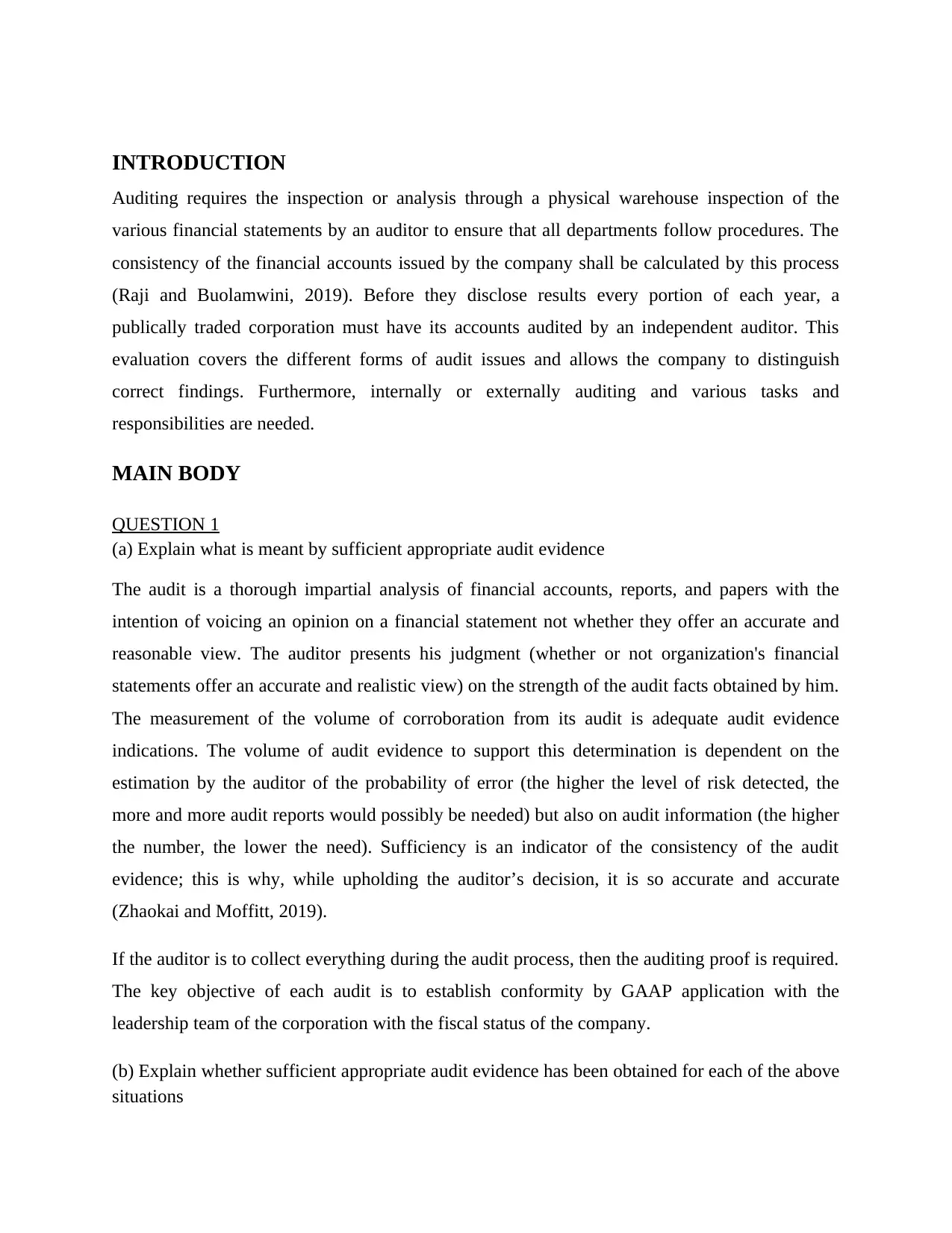
INTRODUCTION
Auditing requires the inspection or analysis through a physical warehouse inspection of the
various financial statements by an auditor to ensure that all departments follow procedures. The
consistency of the financial accounts issued by the company shall be calculated by this process
(Raji and Buolamwini, 2019). Before they disclose results every portion of each year, a
publically traded corporation must have its accounts audited by an independent auditor. This
evaluation covers the different forms of audit issues and allows the company to distinguish
correct findings. Furthermore, internally or externally auditing and various tasks and
responsibilities are needed.
MAIN BODY
QUESTION 1
(a) Explain what is meant by sufficient appropriate audit evidence
The audit is a thorough impartial analysis of financial accounts, reports, and papers with the
intention of voicing an opinion on a financial statement not whether they offer an accurate and
reasonable view. The auditor presents his judgment (whether or not organization's financial
statements offer an accurate and realistic view) on the strength of the audit facts obtained by him.
The measurement of the volume of corroboration from its audit is adequate audit evidence
indications. The volume of audit evidence to support this determination is dependent on the
estimation by the auditor of the probability of error (the higher the level of risk detected, the
more and more audit reports would possibly be needed) but also on audit information (the higher
the number, the lower the need). Sufficiency is an indicator of the consistency of the audit
evidence; this is why, while upholding the auditor’s decision, it is so accurate and accurate
(Zhaokai and Moffitt, 2019).
If the auditor is to collect everything during the audit process, then the auditing proof is required.
The key objective of each audit is to establish conformity by GAAP application with the
leadership team of the corporation with the fiscal status of the company.
(b) Explain whether sufficient appropriate audit evidence has been obtained for each of the above
situations
Auditing requires the inspection or analysis through a physical warehouse inspection of the
various financial statements by an auditor to ensure that all departments follow procedures. The
consistency of the financial accounts issued by the company shall be calculated by this process
(Raji and Buolamwini, 2019). Before they disclose results every portion of each year, a
publically traded corporation must have its accounts audited by an independent auditor. This
evaluation covers the different forms of audit issues and allows the company to distinguish
correct findings. Furthermore, internally or externally auditing and various tasks and
responsibilities are needed.
MAIN BODY
QUESTION 1
(a) Explain what is meant by sufficient appropriate audit evidence
The audit is a thorough impartial analysis of financial accounts, reports, and papers with the
intention of voicing an opinion on a financial statement not whether they offer an accurate and
reasonable view. The auditor presents his judgment (whether or not organization's financial
statements offer an accurate and realistic view) on the strength of the audit facts obtained by him.
The measurement of the volume of corroboration from its audit is adequate audit evidence
indications. The volume of audit evidence to support this determination is dependent on the
estimation by the auditor of the probability of error (the higher the level of risk detected, the
more and more audit reports would possibly be needed) but also on audit information (the higher
the number, the lower the need). Sufficiency is an indicator of the consistency of the audit
evidence; this is why, while upholding the auditor’s decision, it is so accurate and accurate
(Zhaokai and Moffitt, 2019).
If the auditor is to collect everything during the audit process, then the auditing proof is required.
The key objective of each audit is to establish conformity by GAAP application with the
leadership team of the corporation with the fiscal status of the company.
(b) Explain whether sufficient appropriate audit evidence has been obtained for each of the above
situations
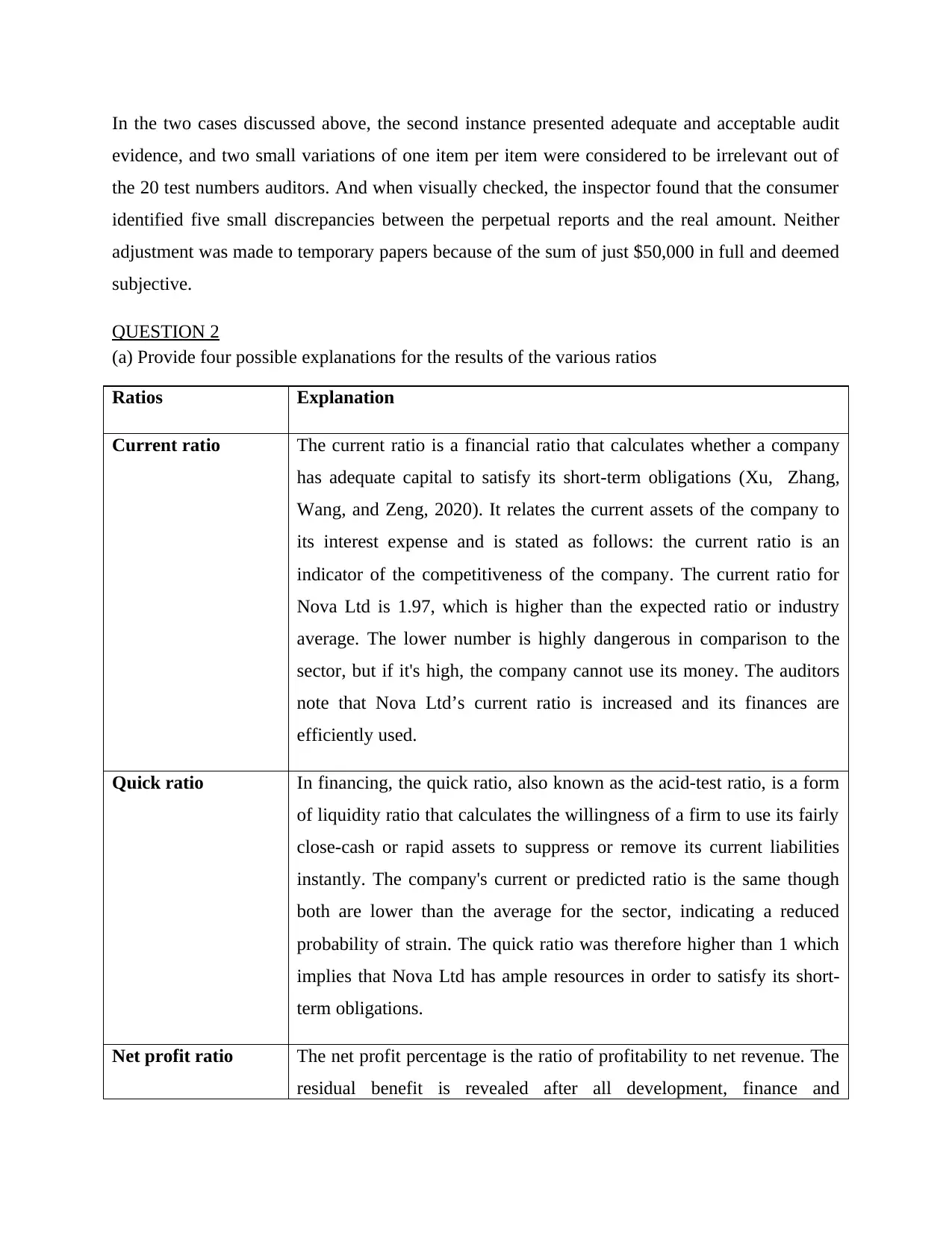
In the two cases discussed above, the second instance presented adequate and acceptable audit
evidence, and two small variations of one item per item were considered to be irrelevant out of
the 20 test numbers auditors. And when visually checked, the inspector found that the consumer
identified five small discrepancies between the perpetual reports and the real amount. Neither
adjustment was made to temporary papers because of the sum of just $50,000 in full and deemed
subjective.
QUESTION 2
(a) Provide four possible explanations for the results of the various ratios
Ratios Explanation
Current ratio The current ratio is a financial ratio that calculates whether a company
has adequate capital to satisfy its short-term obligations (Xu, Zhang,
Wang, and Zeng, 2020). It relates the current assets of the company to
its interest expense and is stated as follows: the current ratio is an
indicator of the competitiveness of the company. The current ratio for
Nova Ltd is 1.97, which is higher than the expected ratio or industry
average. The lower number is highly dangerous in comparison to the
sector, but if it's high, the company cannot use its money. The auditors
note that Nova Ltd’s current ratio is increased and its finances are
efficiently used.
Quick ratio In financing, the quick ratio, also known as the acid-test ratio, is a form
of liquidity ratio that calculates the willingness of a firm to use its fairly
close-cash or rapid assets to suppress or remove its current liabilities
instantly. The company's current or predicted ratio is the same though
both are lower than the average for the sector, indicating a reduced
probability of strain. The quick ratio was therefore higher than 1 which
implies that Nova Ltd has ample resources in order to satisfy its short-
term obligations.
Net profit ratio The net profit percentage is the ratio of profitability to net revenue. The
residual benefit is revealed after all development, finance and
evidence, and two small variations of one item per item were considered to be irrelevant out of
the 20 test numbers auditors. And when visually checked, the inspector found that the consumer
identified five small discrepancies between the perpetual reports and the real amount. Neither
adjustment was made to temporary papers because of the sum of just $50,000 in full and deemed
subjective.
QUESTION 2
(a) Provide four possible explanations for the results of the various ratios
Ratios Explanation
Current ratio The current ratio is a financial ratio that calculates whether a company
has adequate capital to satisfy its short-term obligations (Xu, Zhang,
Wang, and Zeng, 2020). It relates the current assets of the company to
its interest expense and is stated as follows: the current ratio is an
indicator of the competitiveness of the company. The current ratio for
Nova Ltd is 1.97, which is higher than the expected ratio or industry
average. The lower number is highly dangerous in comparison to the
sector, but if it's high, the company cannot use its money. The auditors
note that Nova Ltd’s current ratio is increased and its finances are
efficiently used.
Quick ratio In financing, the quick ratio, also known as the acid-test ratio, is a form
of liquidity ratio that calculates the willingness of a firm to use its fairly
close-cash or rapid assets to suppress or remove its current liabilities
instantly. The company's current or predicted ratio is the same though
both are lower than the average for the sector, indicating a reduced
probability of strain. The quick ratio was therefore higher than 1 which
implies that Nova Ltd has ample resources in order to satisfy its short-
term obligations.
Net profit ratio The net profit percentage is the ratio of profitability to net revenue. The
residual benefit is revealed after all development, finance and
Secure Best Marks with AI Grader
Need help grading? Try our AI Grader for instant feedback on your assignments.
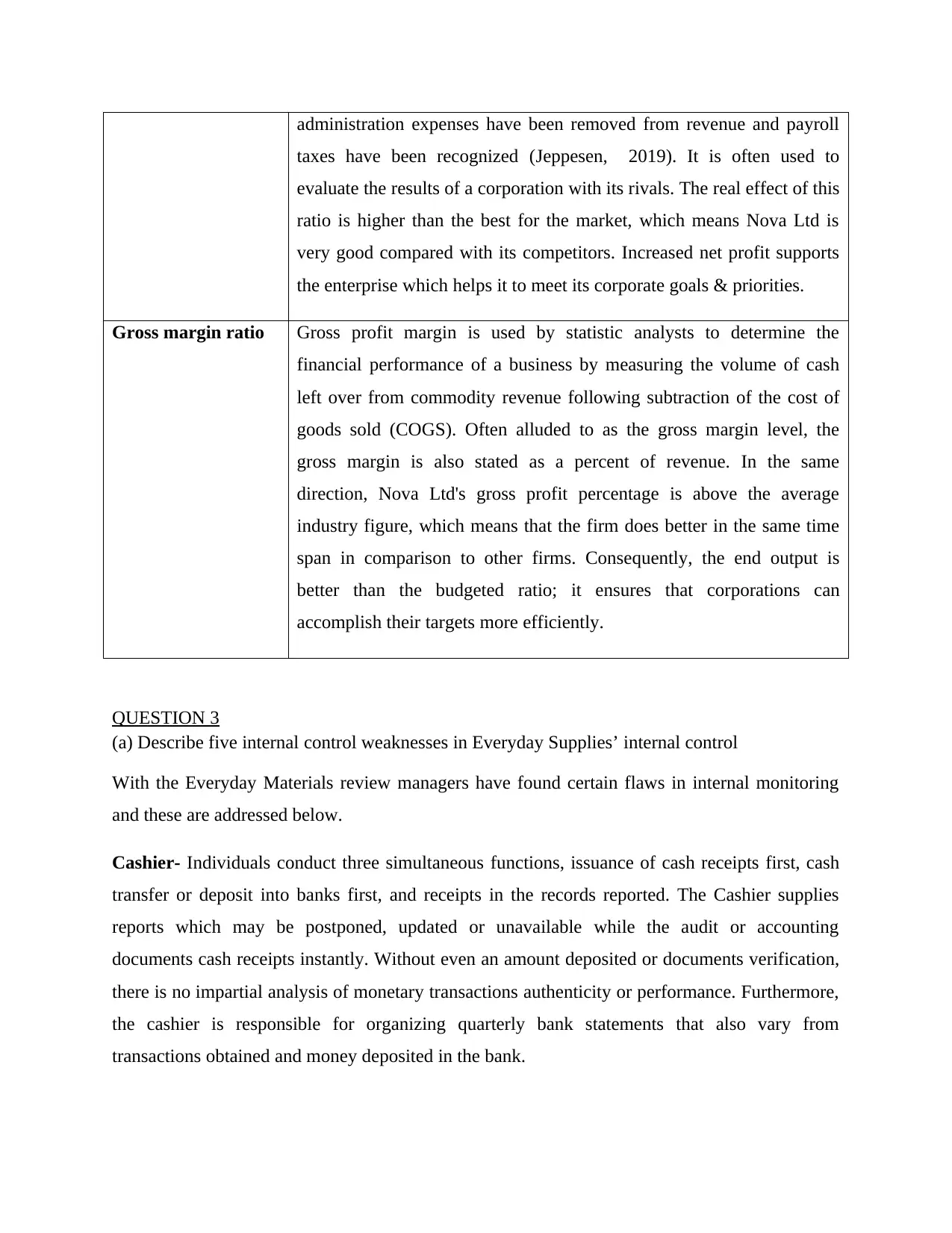
administration expenses have been removed from revenue and payroll
taxes have been recognized (Jeppesen, 2019). It is often used to
evaluate the results of a corporation with its rivals. The real effect of this
ratio is higher than the best for the market, which means Nova Ltd is
very good compared with its competitors. Increased net profit supports
the enterprise which helps it to meet its corporate goals & priorities.
Gross margin ratio Gross profit margin is used by statistic analysts to determine the
financial performance of a business by measuring the volume of cash
left over from commodity revenue following subtraction of the cost of
goods sold (COGS). Often alluded to as the gross margin level, the
gross margin is also stated as a percent of revenue. In the same
direction, Nova Ltd's gross profit percentage is above the average
industry figure, which means that the firm does better in the same time
span in comparison to other firms. Consequently, the end output is
better than the budgeted ratio; it ensures that corporations can
accomplish their targets more efficiently.
QUESTION 3
(a) Describe five internal control weaknesses in Everyday Supplies’ internal control
With the Everyday Materials review managers have found certain flaws in internal monitoring
and these are addressed below.
Cashier- Individuals conduct three simultaneous functions, issuance of cash receipts first, cash
transfer or deposit into banks first, and receipts in the records reported. The Cashier supplies
reports which may be postponed, updated or unavailable while the audit or accounting
documents cash receipts instantly. Without even an amount deposited or documents verification,
there is no impartial analysis of monetary transactions authenticity or performance. Furthermore,
the cashier is responsible for organizing quarterly bank statements that also vary from
transactions obtained and money deposited in the bank.
taxes have been recognized (Jeppesen, 2019). It is often used to
evaluate the results of a corporation with its rivals. The real effect of this
ratio is higher than the best for the market, which means Nova Ltd is
very good compared with its competitors. Increased net profit supports
the enterprise which helps it to meet its corporate goals & priorities.
Gross margin ratio Gross profit margin is used by statistic analysts to determine the
financial performance of a business by measuring the volume of cash
left over from commodity revenue following subtraction of the cost of
goods sold (COGS). Often alluded to as the gross margin level, the
gross margin is also stated as a percent of revenue. In the same
direction, Nova Ltd's gross profit percentage is above the average
industry figure, which means that the firm does better in the same time
span in comparison to other firms. Consequently, the end output is
better than the budgeted ratio; it ensures that corporations can
accomplish their targets more efficiently.
QUESTION 3
(a) Describe five internal control weaknesses in Everyday Supplies’ internal control
With the Everyday Materials review managers have found certain flaws in internal monitoring
and these are addressed below.
Cashier- Individuals conduct three simultaneous functions, issuance of cash receipts first, cash
transfer or deposit into banks first, and receipts in the records reported. The Cashier supplies
reports which may be postponed, updated or unavailable while the audit or accounting
documents cash receipts instantly. Without even an amount deposited or documents verification,
there is no impartial analysis of monetary transactions authenticity or performance. Furthermore,
the cashier is responsible for organizing quarterly bank statements that also vary from
transactions obtained and money deposited in the bank.
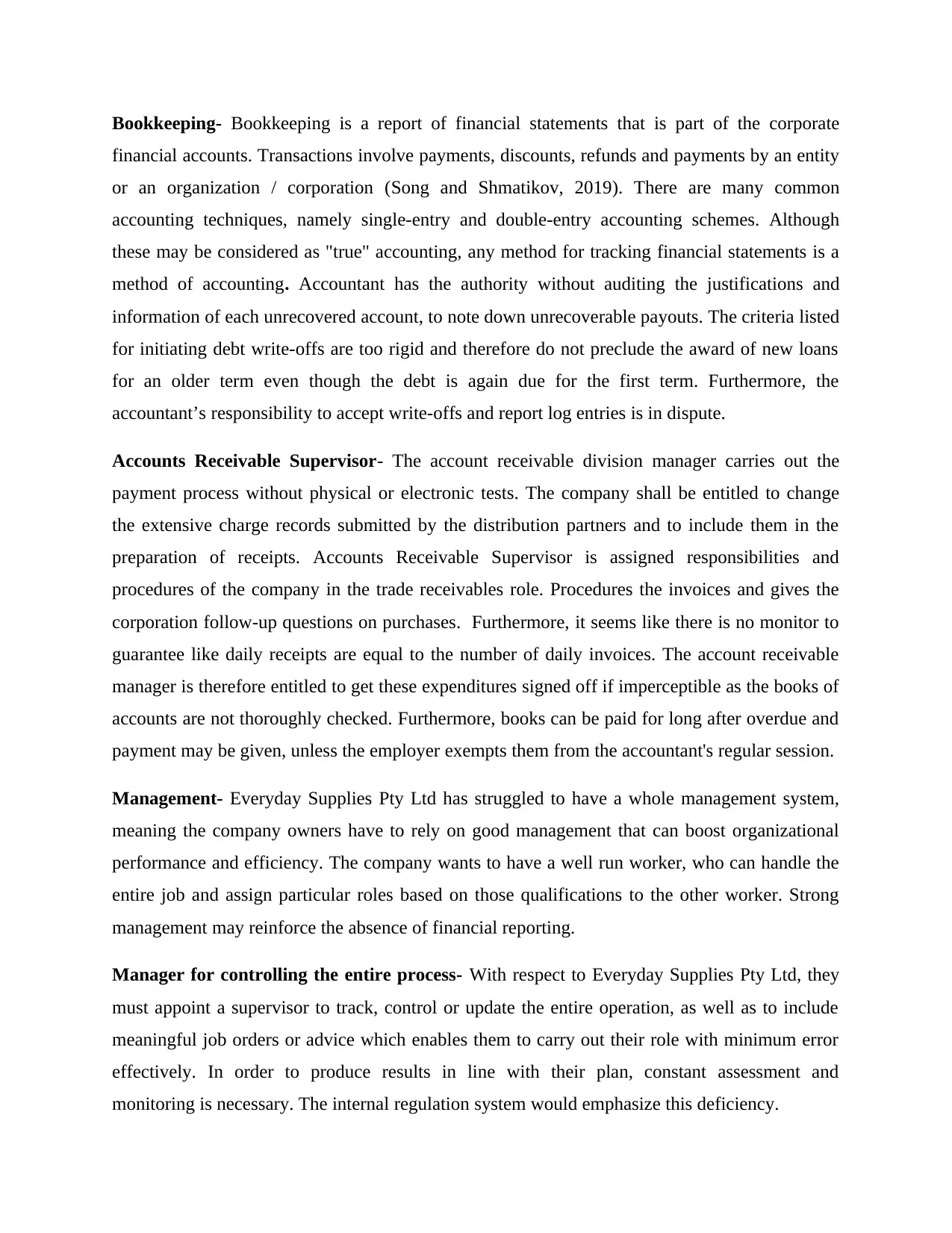
Bookkeeping- Bookkeeping is a report of financial statements that is part of the corporate
financial accounts. Transactions involve payments, discounts, refunds and payments by an entity
or an organization / corporation (Song and Shmatikov, 2019). There are many common
accounting techniques, namely single-entry and double-entry accounting schemes. Although
these may be considered as "true" accounting, any method for tracking financial statements is a
method of accounting. Accountant has the authority without auditing the justifications and
information of each unrecovered account, to note down unrecoverable payouts. The criteria listed
for initiating debt write-offs are too rigid and therefore do not preclude the award of new loans
for an older term even though the debt is again due for the first term. Furthermore, the
accountant’s responsibility to accept write-offs and report log entries is in dispute.
Accounts Receivable Supervisor- The account receivable division manager carries out the
payment process without physical or electronic tests. The company shall be entitled to change
the extensive charge records submitted by the distribution partners and to include them in the
preparation of receipts. Accounts Receivable Supervisor is assigned responsibilities and
procedures of the company in the trade receivables role. Procedures the invoices and gives the
corporation follow-up questions on purchases. Furthermore, it seems like there is no monitor to
guarantee like daily receipts are equal to the number of daily invoices. The account receivable
manager is therefore entitled to get these expenditures signed off if imperceptible as the books of
accounts are not thoroughly checked. Furthermore, books can be paid for long after overdue and
payment may be given, unless the employer exempts them from the accountant's regular session.
Management- Everyday Supplies Pty Ltd has struggled to have a whole management system,
meaning the company owners have to rely on good management that can boost organizational
performance and efficiency. The company wants to have a well run worker, who can handle the
entire job and assign particular roles based on those qualifications to the other worker. Strong
management may reinforce the absence of financial reporting.
Manager for controlling the entire process- With respect to Everyday Supplies Pty Ltd, they
must appoint a supervisor to track, control or update the entire operation, as well as to include
meaningful job orders or advice which enables them to carry out their role with minimum error
effectively. In order to produce results in line with their plan, constant assessment and
monitoring is necessary. The internal regulation system would emphasize this deficiency.
financial accounts. Transactions involve payments, discounts, refunds and payments by an entity
or an organization / corporation (Song and Shmatikov, 2019). There are many common
accounting techniques, namely single-entry and double-entry accounting schemes. Although
these may be considered as "true" accounting, any method for tracking financial statements is a
method of accounting. Accountant has the authority without auditing the justifications and
information of each unrecovered account, to note down unrecoverable payouts. The criteria listed
for initiating debt write-offs are too rigid and therefore do not preclude the award of new loans
for an older term even though the debt is again due for the first term. Furthermore, the
accountant’s responsibility to accept write-offs and report log entries is in dispute.
Accounts Receivable Supervisor- The account receivable division manager carries out the
payment process without physical or electronic tests. The company shall be entitled to change
the extensive charge records submitted by the distribution partners and to include them in the
preparation of receipts. Accounts Receivable Supervisor is assigned responsibilities and
procedures of the company in the trade receivables role. Procedures the invoices and gives the
corporation follow-up questions on purchases. Furthermore, it seems like there is no monitor to
guarantee like daily receipts are equal to the number of daily invoices. The account receivable
manager is therefore entitled to get these expenditures signed off if imperceptible as the books of
accounts are not thoroughly checked. Furthermore, books can be paid for long after overdue and
payment may be given, unless the employer exempts them from the accountant's regular session.
Management- Everyday Supplies Pty Ltd has struggled to have a whole management system,
meaning the company owners have to rely on good management that can boost organizational
performance and efficiency. The company wants to have a well run worker, who can handle the
entire job and assign particular roles based on those qualifications to the other worker. Strong
management may reinforce the absence of financial reporting.
Manager for controlling the entire process- With respect to Everyday Supplies Pty Ltd, they
must appoint a supervisor to track, control or update the entire operation, as well as to include
meaningful job orders or advice which enables them to carry out their role with minimum error
effectively. In order to produce results in line with their plan, constant assessment and
monitoring is necessary. The internal regulation system would emphasize this deficiency.
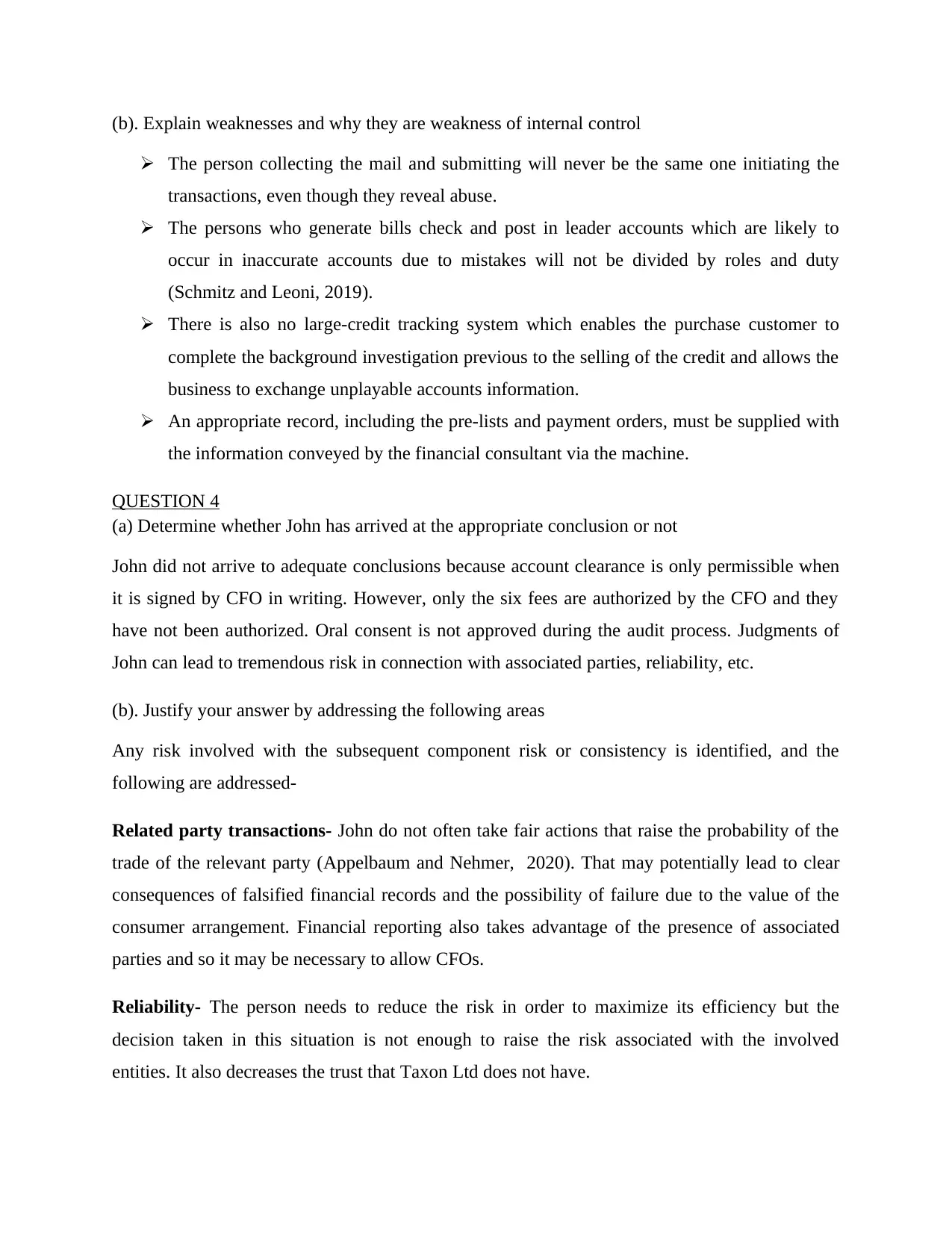
(b). Explain weaknesses and why they are weakness of internal control
The person collecting the mail and submitting will never be the same one initiating the
transactions, even though they reveal abuse.
The persons who generate bills check and post in leader accounts which are likely to
occur in inaccurate accounts due to mistakes will not be divided by roles and duty
(Schmitz and Leoni, 2019).
There is also no large-credit tracking system which enables the purchase customer to
complete the background investigation previous to the selling of the credit and allows the
business to exchange unplayable accounts information.
An appropriate record, including the pre-lists and payment orders, must be supplied with
the information conveyed by the financial consultant via the machine.
QUESTION 4
(a) Determine whether John has arrived at the appropriate conclusion or not
John did not arrive to adequate conclusions because account clearance is only permissible when
it is signed by CFO in writing. However, only the six fees are authorized by the CFO and they
have not been authorized. Oral consent is not approved during the audit process. Judgments of
John can lead to tremendous risk in connection with associated parties, reliability, etc.
(b). Justify your answer by addressing the following areas
Any risk involved with the subsequent component risk or consistency is identified, and the
following are addressed-
Related party transactions- John do not often take fair actions that raise the probability of the
trade of the relevant party (Appelbaum and Nehmer, 2020). That may potentially lead to clear
consequences of falsified financial records and the possibility of failure due to the value of the
consumer arrangement. Financial reporting also takes advantage of the presence of associated
parties and so it may be necessary to allow CFOs.
Reliability- The person needs to reduce the risk in order to maximize its efficiency but the
decision taken in this situation is not enough to raise the risk associated with the involved
entities. It also decreases the trust that Taxon Ltd does not have.
The person collecting the mail and submitting will never be the same one initiating the
transactions, even though they reveal abuse.
The persons who generate bills check and post in leader accounts which are likely to
occur in inaccurate accounts due to mistakes will not be divided by roles and duty
(Schmitz and Leoni, 2019).
There is also no large-credit tracking system which enables the purchase customer to
complete the background investigation previous to the selling of the credit and allows the
business to exchange unplayable accounts information.
An appropriate record, including the pre-lists and payment orders, must be supplied with
the information conveyed by the financial consultant via the machine.
QUESTION 4
(a) Determine whether John has arrived at the appropriate conclusion or not
John did not arrive to adequate conclusions because account clearance is only permissible when
it is signed by CFO in writing. However, only the six fees are authorized by the CFO and they
have not been authorized. Oral consent is not approved during the audit process. Judgments of
John can lead to tremendous risk in connection with associated parties, reliability, etc.
(b). Justify your answer by addressing the following areas
Any risk involved with the subsequent component risk or consistency is identified, and the
following are addressed-
Related party transactions- John do not often take fair actions that raise the probability of the
trade of the relevant party (Appelbaum and Nehmer, 2020). That may potentially lead to clear
consequences of falsified financial records and the possibility of failure due to the value of the
consumer arrangement. Financial reporting also takes advantage of the presence of associated
parties and so it may be necessary to allow CFOs.
Reliability- The person needs to reduce the risk in order to maximize its efficiency but the
decision taken in this situation is not enough to raise the risk associated with the involved
entities. It also decreases the trust that Taxon Ltd does not have.
Paraphrase This Document
Need a fresh take? Get an instant paraphrase of this document with our AI Paraphraser
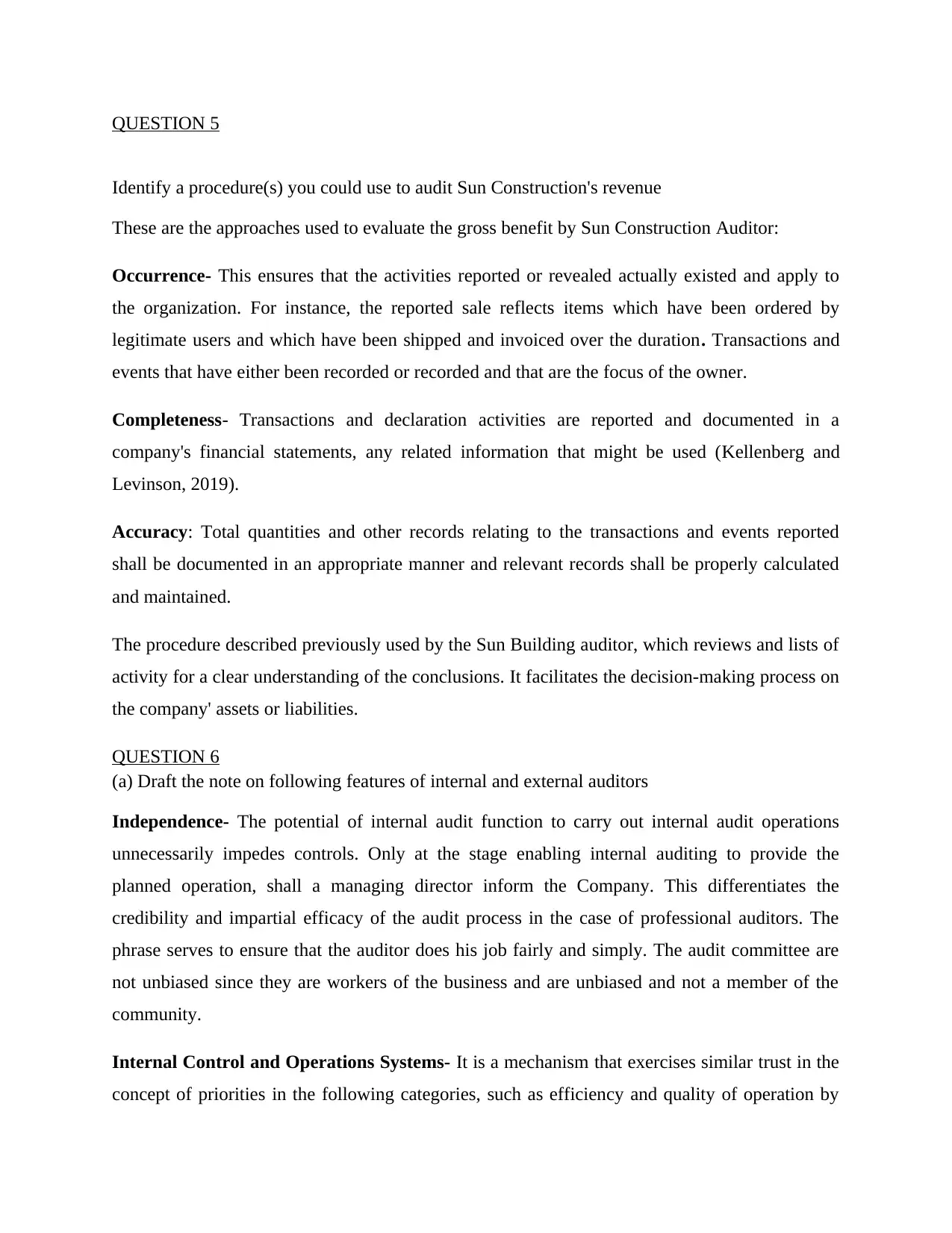
QUESTION 5
Identify a procedure(s) you could use to audit Sun Construction's revenue
These are the approaches used to evaluate the gross benefit by Sun Construction Auditor:
Occurrence- This ensures that the activities reported or revealed actually existed and apply to
the organization. For instance, the reported sale reflects items which have been ordered by
legitimate users and which have been shipped and invoiced over the duration. Transactions and
events that have either been recorded or recorded and that are the focus of the owner.
Completeness- Transactions and declaration activities are reported and documented in a
company's financial statements, any related information that might be used (Kellenberg and
Levinson, 2019).
Accuracy: Total quantities and other records relating to the transactions and events reported
shall be documented in an appropriate manner and relevant records shall be properly calculated
and maintained.
The procedure described previously used by the Sun Building auditor, which reviews and lists of
activity for a clear understanding of the conclusions. It facilitates the decision-making process on
the company' assets or liabilities.
QUESTION 6
(a) Draft the note on following features of internal and external auditors
Independence- The potential of internal audit function to carry out internal audit operations
unnecessarily impedes controls. Only at the stage enabling internal auditing to provide the
planned operation, shall a managing director inform the Company. This differentiates the
credibility and impartial efficacy of the audit process in the case of professional auditors. The
phrase serves to ensure that the auditor does his job fairly and simply. The audit committee are
not unbiased since they are workers of the business and are unbiased and not a member of the
community.
Internal Control and Operations Systems- It is a mechanism that exercises similar trust in the
concept of priorities in the following categories, such as efficiency and quality of operation by
Identify a procedure(s) you could use to audit Sun Construction's revenue
These are the approaches used to evaluate the gross benefit by Sun Construction Auditor:
Occurrence- This ensures that the activities reported or revealed actually existed and apply to
the organization. For instance, the reported sale reflects items which have been ordered by
legitimate users and which have been shipped and invoiced over the duration. Transactions and
events that have either been recorded or recorded and that are the focus of the owner.
Completeness- Transactions and declaration activities are reported and documented in a
company's financial statements, any related information that might be used (Kellenberg and
Levinson, 2019).
Accuracy: Total quantities and other records relating to the transactions and events reported
shall be documented in an appropriate manner and relevant records shall be properly calculated
and maintained.
The procedure described previously used by the Sun Building auditor, which reviews and lists of
activity for a clear understanding of the conclusions. It facilitates the decision-making process on
the company' assets or liabilities.
QUESTION 6
(a) Draft the note on following features of internal and external auditors
Independence- The potential of internal audit function to carry out internal audit operations
unnecessarily impedes controls. Only at the stage enabling internal auditing to provide the
planned operation, shall a managing director inform the Company. This differentiates the
credibility and impartial efficacy of the audit process in the case of professional auditors. The
phrase serves to ensure that the auditor does his job fairly and simply. The audit committee are
not unbiased since they are workers of the business and are unbiased and not a member of the
community.
Internal Control and Operations Systems- It is a mechanism that exercises similar trust in the
concept of priorities in the following categories, such as efficiency and quality of operation by
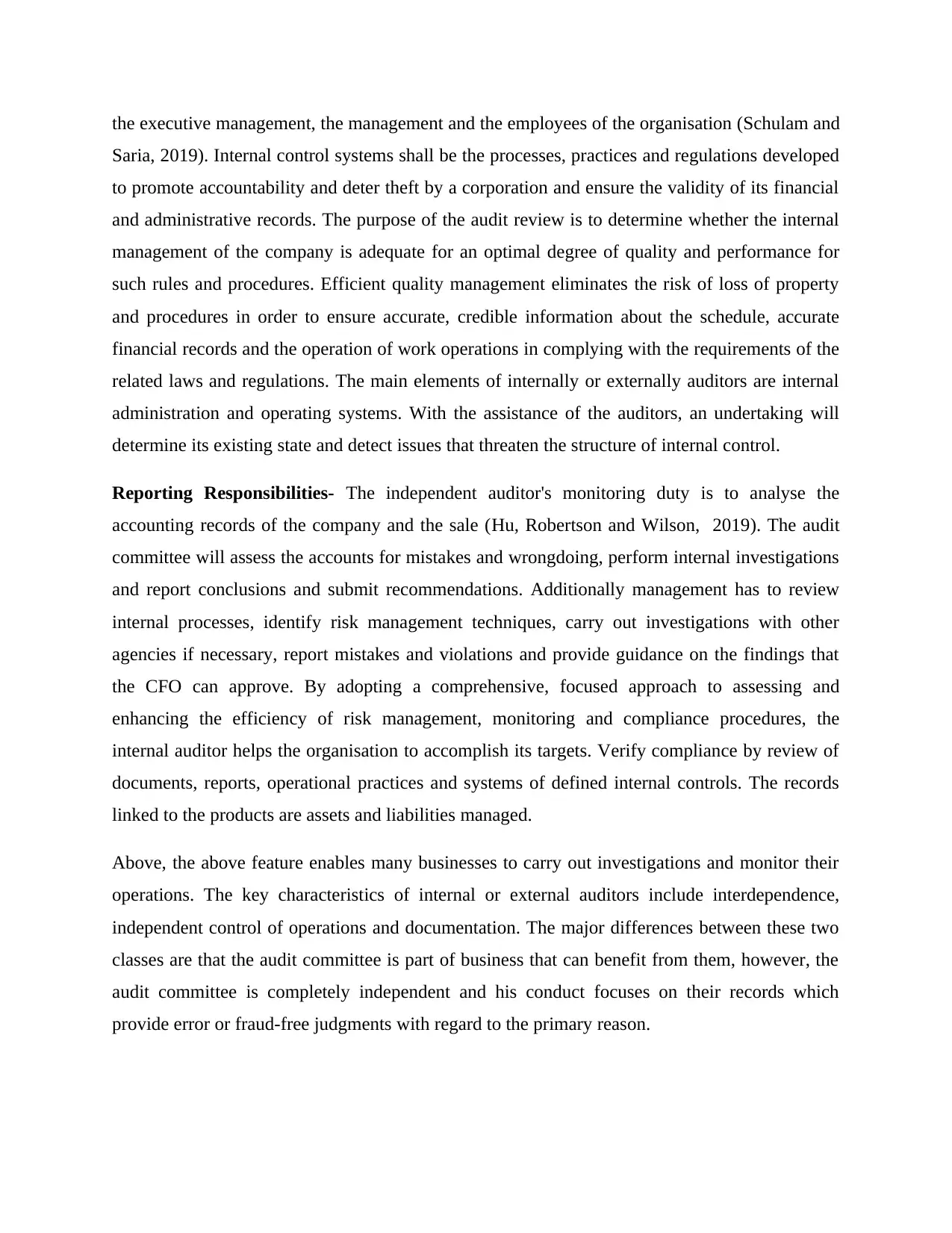
the executive management, the management and the employees of the organisation (Schulam and
Saria, 2019). Internal control systems shall be the processes, practices and regulations developed
to promote accountability and deter theft by a corporation and ensure the validity of its financial
and administrative records. The purpose of the audit review is to determine whether the internal
management of the company is adequate for an optimal degree of quality and performance for
such rules and procedures. Efficient quality management eliminates the risk of loss of property
and procedures in order to ensure accurate, credible information about the schedule, accurate
financial records and the operation of work operations in complying with the requirements of the
related laws and regulations. The main elements of internally or externally auditors are internal
administration and operating systems. With the assistance of the auditors, an undertaking will
determine its existing state and detect issues that threaten the structure of internal control.
Reporting Responsibilities- The independent auditor's monitoring duty is to analyse the
accounting records of the company and the sale (Hu, Robertson and Wilson, 2019). The audit
committee will assess the accounts for mistakes and wrongdoing, perform internal investigations
and report conclusions and submit recommendations. Additionally management has to review
internal processes, identify risk management techniques, carry out investigations with other
agencies if necessary, report mistakes and violations and provide guidance on the findings that
the CFO can approve. By adopting a comprehensive, focused approach to assessing and
enhancing the efficiency of risk management, monitoring and compliance procedures, the
internal auditor helps the organisation to accomplish its targets. Verify compliance by review of
documents, reports, operational practices and systems of defined internal controls. The records
linked to the products are assets and liabilities managed.
Above, the above feature enables many businesses to carry out investigations and monitor their
operations. The key characteristics of internal or external auditors include interdependence,
independent control of operations and documentation. The major differences between these two
classes are that the audit committee is part of business that can benefit from them, however, the
audit committee is completely independent and his conduct focuses on their records which
provide error or fraud-free judgments with regard to the primary reason.
Saria, 2019). Internal control systems shall be the processes, practices and regulations developed
to promote accountability and deter theft by a corporation and ensure the validity of its financial
and administrative records. The purpose of the audit review is to determine whether the internal
management of the company is adequate for an optimal degree of quality and performance for
such rules and procedures. Efficient quality management eliminates the risk of loss of property
and procedures in order to ensure accurate, credible information about the schedule, accurate
financial records and the operation of work operations in complying with the requirements of the
related laws and regulations. The main elements of internally or externally auditors are internal
administration and operating systems. With the assistance of the auditors, an undertaking will
determine its existing state and detect issues that threaten the structure of internal control.
Reporting Responsibilities- The independent auditor's monitoring duty is to analyse the
accounting records of the company and the sale (Hu, Robertson and Wilson, 2019). The audit
committee will assess the accounts for mistakes and wrongdoing, perform internal investigations
and report conclusions and submit recommendations. Additionally management has to review
internal processes, identify risk management techniques, carry out investigations with other
agencies if necessary, report mistakes and violations and provide guidance on the findings that
the CFO can approve. By adopting a comprehensive, focused approach to assessing and
enhancing the efficiency of risk management, monitoring and compliance procedures, the
internal auditor helps the organisation to accomplish its targets. Verify compliance by review of
documents, reports, operational practices and systems of defined internal controls. The records
linked to the products are assets and liabilities managed.
Above, the above feature enables many businesses to carry out investigations and monitor their
operations. The key characteristics of internal or external auditors include interdependence,
independent control of operations and documentation. The major differences between these two
classes are that the audit committee is part of business that can benefit from them, however, the
audit committee is completely independent and his conduct focuses on their records which
provide error or fraud-free judgments with regard to the primary reason.
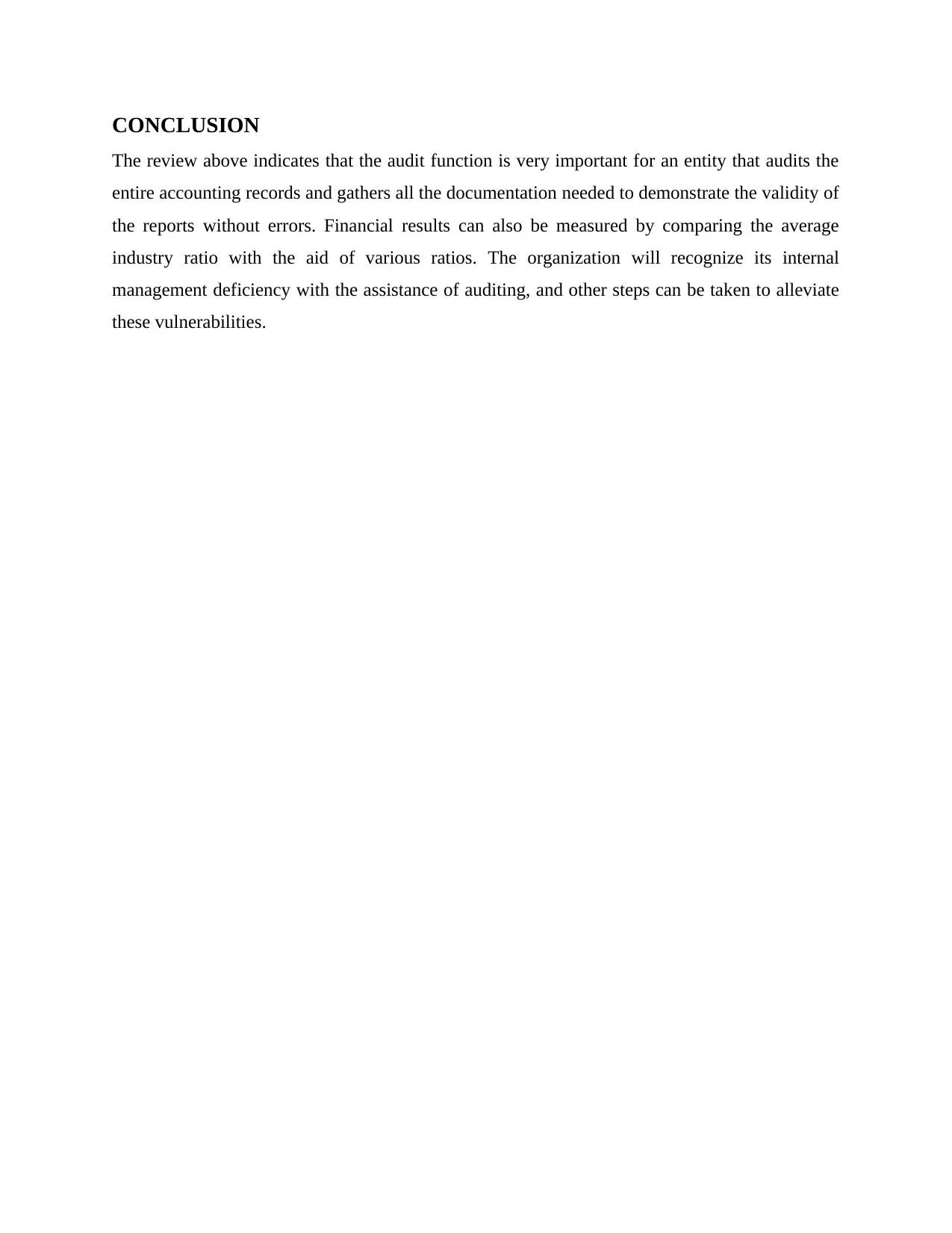
CONCLUSION
The review above indicates that the audit function is very important for an entity that audits the
entire accounting records and gathers all the documentation needed to demonstrate the validity of
the reports without errors. Financial results can also be measured by comparing the average
industry ratio with the aid of various ratios. The organization will recognize its internal
management deficiency with the assistance of auditing, and other steps can be taken to alleviate
these vulnerabilities.
The review above indicates that the audit function is very important for an entity that audits the
entire accounting records and gathers all the documentation needed to demonstrate the validity of
the reports without errors. Financial results can also be measured by comparing the average
industry ratio with the aid of various ratios. The organization will recognize its internal
management deficiency with the assistance of auditing, and other steps can be taken to alleviate
these vulnerabilities.
Secure Best Marks with AI Grader
Need help grading? Try our AI Grader for instant feedback on your assignments.
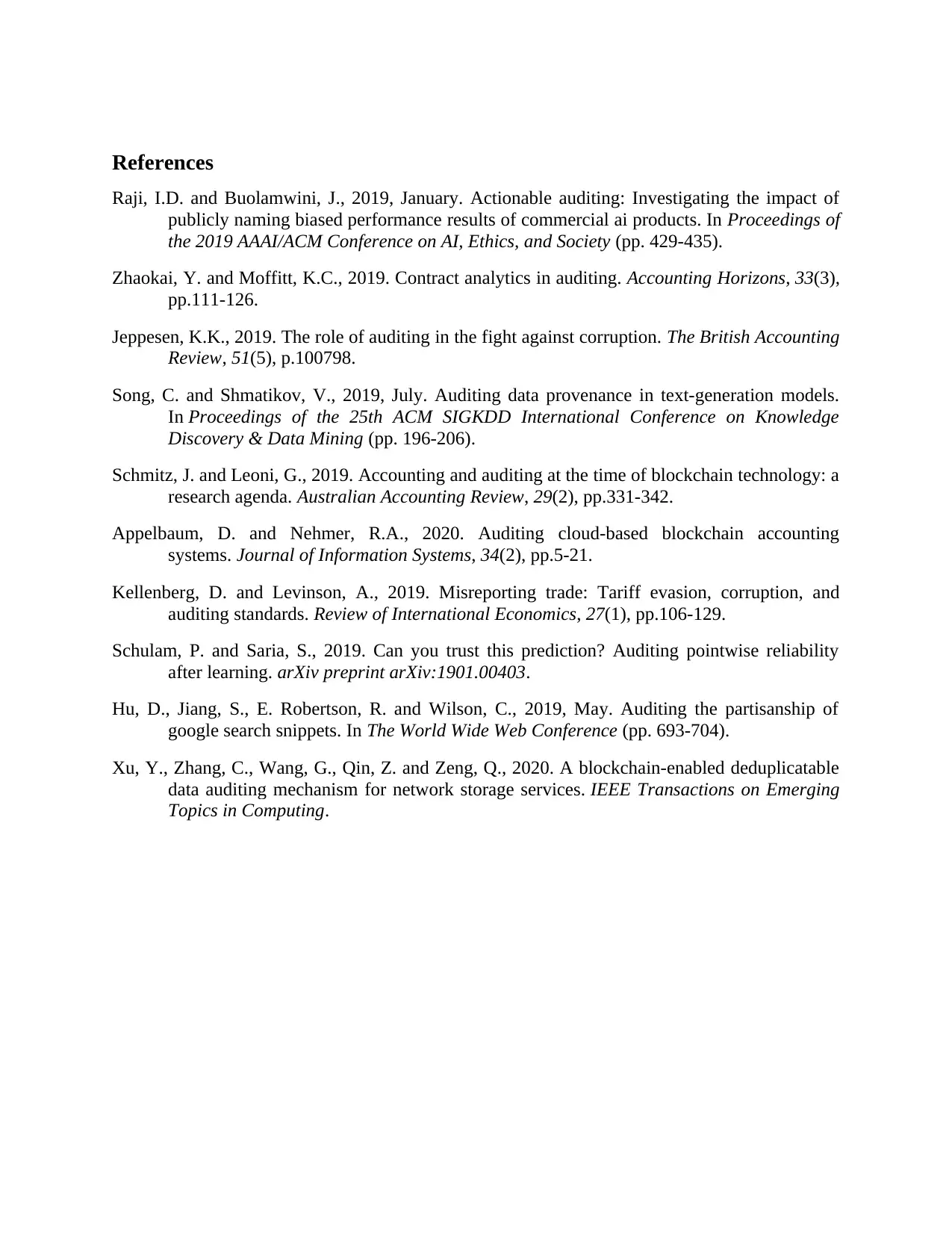
References
Raji, I.D. and Buolamwini, J., 2019, January. Actionable auditing: Investigating the impact of
publicly naming biased performance results of commercial ai products. In Proceedings of
the 2019 AAAI/ACM Conference on AI, Ethics, and Society (pp. 429-435).
Zhaokai, Y. and Moffitt, K.C., 2019. Contract analytics in auditing. Accounting Horizons, 33(3),
pp.111-126.
Jeppesen, K.K., 2019. The role of auditing in the fight against corruption. The British Accounting
Review, 51(5), p.100798.
Song, C. and Shmatikov, V., 2019, July. Auditing data provenance in text-generation models.
In Proceedings of the 25th ACM SIGKDD International Conference on Knowledge
Discovery & Data Mining (pp. 196-206).
Schmitz, J. and Leoni, G., 2019. Accounting and auditing at the time of blockchain technology: a
research agenda. Australian Accounting Review, 29(2), pp.331-342.
Appelbaum, D. and Nehmer, R.A., 2020. Auditing cloud-based blockchain accounting
systems. Journal of Information Systems, 34(2), pp.5-21.
Kellenberg, D. and Levinson, A., 2019. Misreporting trade: Tariff evasion, corruption, and
auditing standards. Review of International Economics, 27(1), pp.106-129.
Schulam, P. and Saria, S., 2019. Can you trust this prediction? Auditing pointwise reliability
after learning. arXiv preprint arXiv:1901.00403.
Hu, D., Jiang, S., E. Robertson, R. and Wilson, C., 2019, May. Auditing the partisanship of
google search snippets. In The World Wide Web Conference (pp. 693-704).
Xu, Y., Zhang, C., Wang, G., Qin, Z. and Zeng, Q., 2020. A blockchain-enabled deduplicatable
data auditing mechanism for network storage services. IEEE Transactions on Emerging
Topics in Computing.
Raji, I.D. and Buolamwini, J., 2019, January. Actionable auditing: Investigating the impact of
publicly naming biased performance results of commercial ai products. In Proceedings of
the 2019 AAAI/ACM Conference on AI, Ethics, and Society (pp. 429-435).
Zhaokai, Y. and Moffitt, K.C., 2019. Contract analytics in auditing. Accounting Horizons, 33(3),
pp.111-126.
Jeppesen, K.K., 2019. The role of auditing in the fight against corruption. The British Accounting
Review, 51(5), p.100798.
Song, C. and Shmatikov, V., 2019, July. Auditing data provenance in text-generation models.
In Proceedings of the 25th ACM SIGKDD International Conference on Knowledge
Discovery & Data Mining (pp. 196-206).
Schmitz, J. and Leoni, G., 2019. Accounting and auditing at the time of blockchain technology: a
research agenda. Australian Accounting Review, 29(2), pp.331-342.
Appelbaum, D. and Nehmer, R.A., 2020. Auditing cloud-based blockchain accounting
systems. Journal of Information Systems, 34(2), pp.5-21.
Kellenberg, D. and Levinson, A., 2019. Misreporting trade: Tariff evasion, corruption, and
auditing standards. Review of International Economics, 27(1), pp.106-129.
Schulam, P. and Saria, S., 2019. Can you trust this prediction? Auditing pointwise reliability
after learning. arXiv preprint arXiv:1901.00403.
Hu, D., Jiang, S., E. Robertson, R. and Wilson, C., 2019, May. Auditing the partisanship of
google search snippets. In The World Wide Web Conference (pp. 693-704).
Xu, Y., Zhang, C., Wang, G., Qin, Z. and Zeng, Q., 2020. A blockchain-enabled deduplicatable
data auditing mechanism for network storage services. IEEE Transactions on Emerging
Topics in Computing.
1 out of 11
Related Documents
Your All-in-One AI-Powered Toolkit for Academic Success.
+13062052269
info@desklib.com
Available 24*7 on WhatsApp / Email
![[object Object]](/_next/static/media/star-bottom.7253800d.svg)
Unlock your academic potential
© 2024 | Zucol Services PVT LTD | All rights reserved.





